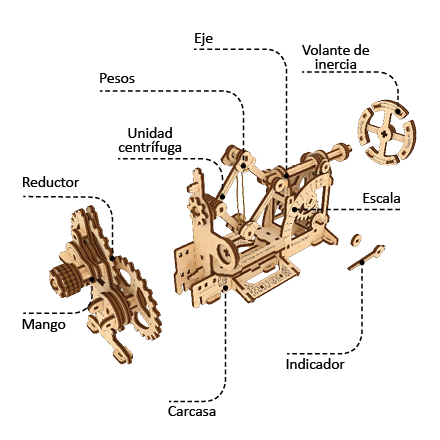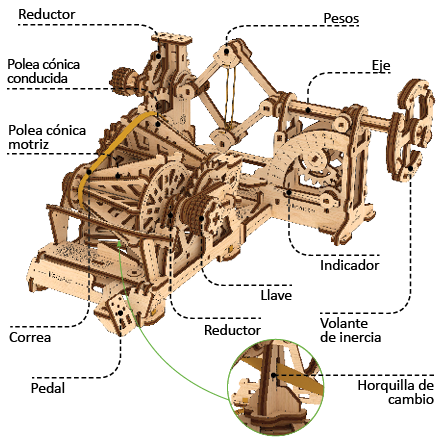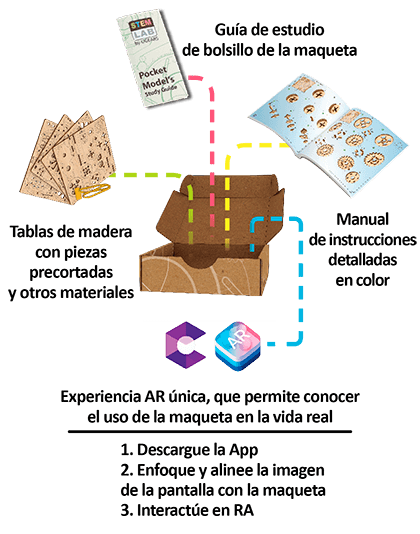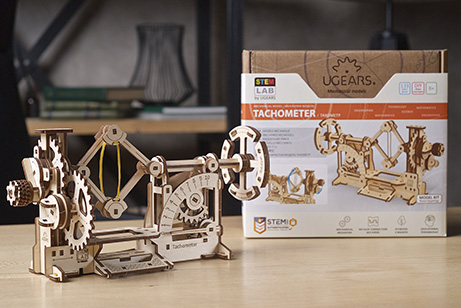

Dimensiones de la maqueta: 24*10,3*12,3 cm
Medidas del paquete: 20,5*18,8*6,3 cm
Número de componentes: 117
Móntelo y descubra cómo funciona el Tacómetro
Un tacómetro es un dispositivo que mide la velocidad de giro de diferentes partes en motores u otros mecanismos. Sus mediciones se realizan en revoluciones por minuto (RPM). El tacómetro también mide y monitora los límites de carga para reducir o aumentar las RPM, de manera que el motor o el mecanismo funcione dentro de sus parámetros óptimos.
El tacómetro fue inventado en 1817 por el ingeniero alemán Dietrich Uhlhorn. Su invención fue un dispositivo especial que medía la fuerza centrífuga. A partir de 1840, estos dispositivos se utilizaron en las locomotoras de trenes, y más tarde en coches y vehículos de todo tipo.
Un tacómetro se utiliza en mecanismos que requieren un seguimiento exacto de las RPM para evitar consecuencias negativas por sobrecarga. Conductores espabilados usan los tacómetros para saber cuándo tienen que cambiar las marchas (en coches con transmisión manual) y para controlar la carga del motor, aumentando así la vida útil de sus vehículos.
El Tacómetro, un puzzle 3D de madera de la colección STEM-Lab de Ugears, es una maqueta de bricolaje completamente operativa, esperando a que usted la ensamble. Al girar el mango, el movimiento se transmite a través del reductor, aumentando las RPM y desplazando los dos pesos en la unidad centrífuga. Cuanto mayor sean las RPM, más se separarán los pesos debido a la fuerza centrífuga, desplazando así un eje móvil con un volante de inercia. En este eje está fijado un mecanismo indicador (escala). Cuanto más se mueva el eje (aumento de las RPM), más se desplazará la flecha de la escala, indicando una mayor velocidad de giro.
 |
El Tacómetro comprende:
|
El sistema Variomatic-Tacómetro refleja la interacción directa entre la relación de transmisión de la caja de cambios y la velocidad de rotación.
Girando el mango del Variomatic, el movimiento se transmitirá por el reductor a la polea cónica de transmisión. La rotación de la primera polea cónica es transmitida posteriormente a través de la correa a otra polea cónica, la polea conducida. Pulsando el pedal que está fijado en la carcasa, se mueve la horquilla que sujeta la correa, cambiando así la velocidad de rotación de la polea conducida. Si el Tacómetro está unido al Variomatic, el cambio de la velocidad de giro de la polea conducida del Variomatic se transmite al reductor del Tacómetro. Esto a su vez aumentará o reducirá la fuerza centrífuga ejercida sobre los pesos que desplazan el eje con el volante de inercia. Debido al movimiento del eje se desplaza el indicador en la escala hacia un valor superior o inferior. De esta manera, los cambios de la relación de transmisión del Variomatic se indicarán en forma de incremento o reducción de las RPM en el Tacómetro conectado.
 |
El mecanismo Variomatic-Tacómetro
|
Los puzzles 3D de la colección STEM de Ugears están diseñados para adaptarse a distintos grupos de edades con un enfoque especial en el estudio de mecanismos. El montaje de este rompecabezas de madera es apasionante y no lleva mucho tiempo.
|
Las maquetas para montar STEM-Lab se suministran con todo lo necesario comprendido en una caja. Como las demás maquetas para montar de madera de Ugears, el montaje de los modelos STEM-Lab es divertido e integral: Todo lo que necesita para montar, aprender y descubrir viene en la caja. Ésta incluye:
|
 |

Dimensiones de la maqueta: 24*10,3*12,3 cm
Medidas del paquete: 20,5*18,8*6,3 cm


Todas las piezas están precortadas y listas para su montaje

Los modelos reproducen movimiento

No necesario pegamento ni sustancias químicas para el montaje

Perfecto para proyectos familiares a través del aprendizaje STEM.